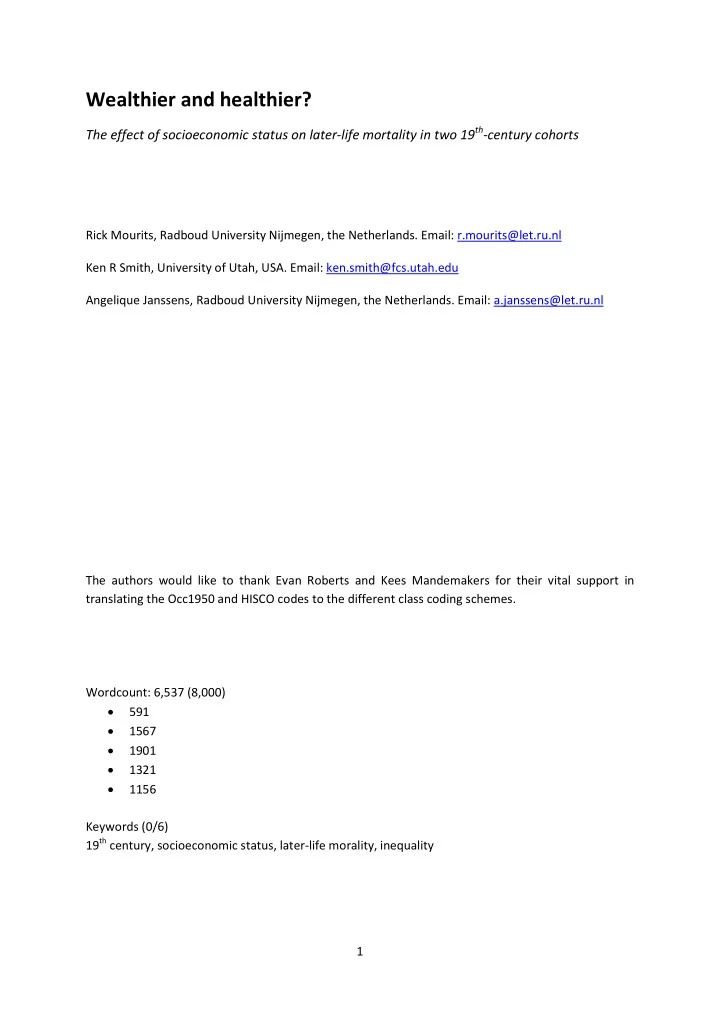

Wealthier and healthier? The effect of socioeconomic status on later-life mortality in two 19 th -century cohorts Rick Mourits, Radboud University Nijmegen, the Netherlands. Email: r.mourits@let.ru.nl Ken R Smith, University of Utah, USA. Email: ken.smith@fcs.utah.edu Angelique Janssens, Radboud University Nijmegen, the Netherlands. Email: a.janssens@let.ru.nl The authors would like to thank Evan Roberts and Kees Mandemakers for their vital support in translating the Occ1950 and HISCO codes to the different class coding schemes. Wordcount: 6,537 (8,000) 591 1567 1901 1321 1156 Keywords (0/6) 19 th century, socioeconomic status, later-life morality, inequality 1
Abstract 150-250 Studies on contemporary populations have shown that socioeconomic status is strongly related with one’s life expectancy. Yet, little is known about the relationship between socioeconomic status and individual survival in the past, as research has focused on when social inequalities started appeared. Although SES is thought to be one of the most important predictors of survival for 20 th -century cohorts, the effect seems absent for those who lived and died before WWII. Recently, Temby and Smith (2014) found a link between longevity and socioeconomic status for 19 th -century cohorts in Utah after they controlled for similarities between siblings. In this paper, we study the robustness of Smith affect the link between socioeconomic status and mortality after age 50 in the Utahn 1860- 1890 cohort and the 1812-1862 cohort from the Dutch province Zeeland. 2
1. Introduction Stratification of health by social standing and income is one of the axioms in social science (Elo, 2009). Higher socioeconomic status significantly increases an individual’s survival chances in later- life, culminating in longer and healthier lifespans for those at the top of the social pyramid (Antonovksy, 1967; Bobak, Pikhart, Rose, Hertzman, & Marmot, 2000; Chen, Yang, & Liu, 2010; Huisman, Kunst, & Mackenbach, 2003; Kunst et al., 2004; Mackenbach et al., 2008; Zimmer, Hanson, & Smith, 2016a). Individuals from the lowest income and educational groups are 1.2 to 1.8 times as likely to report that they live in poor health than the highest social groups (Mackenbach et al., 2008; Zimmer et al., 2016a). Moreover, the death rate of the lowest social class is 1.5 to 2 times as high as the death rate of the highest social class in Western Europe (Mackenbach et al., 2008), culminating in a lower life expectancy of two to three years for men and about one year for women (Kunst et al., 2004). Yet, these patterns might be unique for contemporary societies, as class-based disparencies in later-life expectancy seem to have been different for individuals born before the 20 th century (Bengtsson & van Poppel, 2011; Edvinsson & Broström, 2012). Whether the wealthier have always been healthier is a long-standing discussion. A wide collection of studies on historical socioeconomic differentials in infant mortality, child mortality, and adult mortality provides little evidence of a socioeconomic graduent in mortality (Bengtsson & van Poppel, 2011). Recently, multiple studies shifted their focus to class differences in later-life mortality. Most of these papers showed that mortality risks in later life were elevated for the elite and lower for farmers in 19 th -century cohorts (Edvinsson & Broström, 2012; Ferrie, 2003; Gagnon, Tremblay, Vézina, & Seabrook, 2011; Schenk & van Poppel, 2011; Smith, Mineau, Garibotti, & Kerber, 2009; Temby & Smith, 2014). The relationship between socioeconomic status and later-life survival is still less clear when examined across time and place. In Utah, there was a positive effect of socioeconomic status on survival after age 50 and the chance of belonging to the top 5% of survivors (Smith et al., 2009; Temby & Smith, 2014). Similarly, survival in later life increased linearly by occupation in Québec and by income in Sart, Belgium (Alter, Neven, & Oris, 2004; Gagnon et al., 2011). Yet, other papers on Belgium, the Netherlands, and Sweden have not been able to establish a connection between social position and later-life mortality (Bengtsson & Dribe, 2011; Donrovich, Puschmann, & Matthijs, 2014; Edvinsson & Broström, 2012; Schenk & van Poppel, 2011). Hitherto, different papers have applied different measures of social class, rendering it hard to determine whether diverging results were caused by methodological decisions or actual differences . In this paper we enquire whether the different findings were caused by spatial and temporal differences or methodological decisions. Eight different social class schemata are used to test the positive relationship between socioeconomic status and later-life survival that Smith et al. (2009) and Temby and Smith (2014) found for 19 th -century cohorts. The same results are also produced for 19 th - century cohorts from the Dutch coastal province of Zeeland. Combined, the datasets offer a rare insight in the 19 th -century population dynamics of two radically different populations: a fledgling industrializing society on the American frontier and an established commercial-agricultural society in the old world. We ask ourselves two questions: (1) What is the relationship between socioeconomic status and later-life mortality in Utah and Zeeland? and (2) To what extent are results affected by methodological choices, i.e. the operationalization of SES? 2.1 Socioeconomic status and later-life mortality The lives of individuals born in the 19 th century were rather different from the lives that we live today. The 19 th century was an age of transition: the western world industrialized, developed the 3
Recommend
More recommend